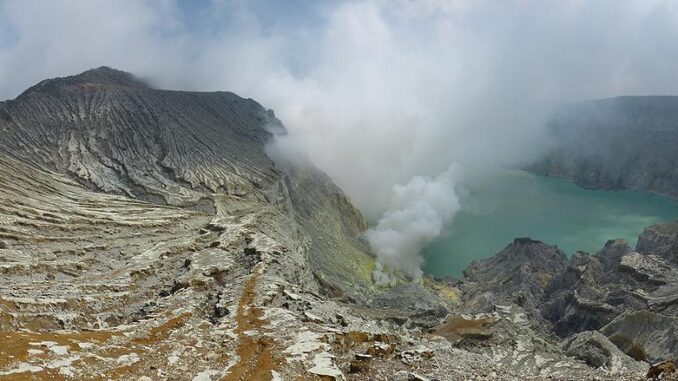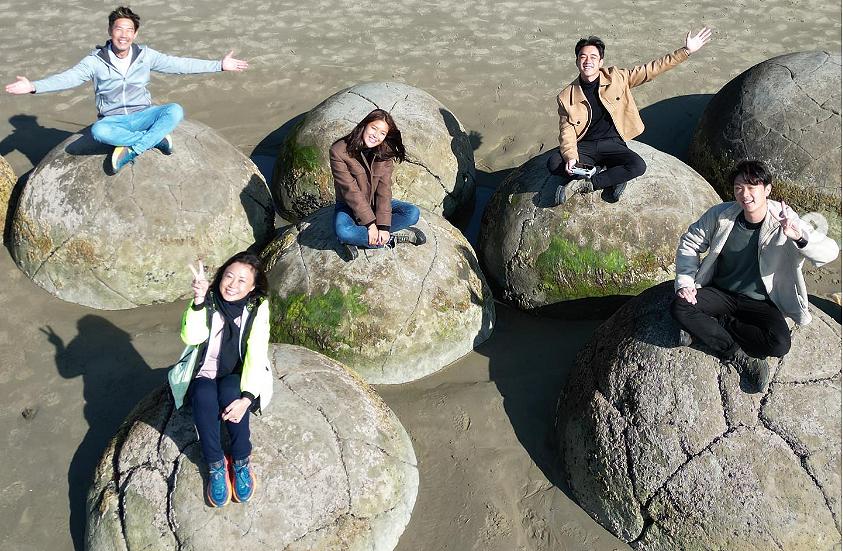
PARIS, FRANCE, May 24, 2023 (ENS) – The United Nations is adding 18 new sites to its network of top geoparks, showcasing the planet’s most spectacular sites of natural beauty. The UNESCO Global Geopark designation was created in 2015 to recognize „geographic heritage of international importance”.
Geoparks serve local communities by combining conservation with public relations and a sustainable approach to development. UNESCO, the United Nations Educational, Scientific and Cultural Organization, today announced a new list of Geoparks. Two UNESCO member states are joining the network for the first time – New Zealand and the Philippines.
Two new geoparks are in Brazil and four have been designated in Indonesia. Iran has two new geoparks, while the other 10 countries on the list have one new geopark each: Greece, Japan, Malaysia, New Zealand, Norway, the Philippines, South Korea, Spain, Thailand and the United Kingdom.
The 18 new names bring the total to 195 UNESCO Geoparks in 48 countries. They have a total area of 486,709 square kilometers (187,919 sq mi), roughly twice the size of the United Kingdom.
New Geoparks:
Brazil: Caçapava Geopark
For the Guarani tribe in Brazil, this geopark is the „where the forest ends”, located in Rio Grande do Sul state in southern Brazil. Its geological heritage of mining sulphide metals and marble has been vital to the economic development of the region. Apart from the biodiversity, the geopark is home to endangered cacti, bromeliads, endemic flowers and bee species.
Brazil: Quarta Colonia Geopark
This geopark is located in the south of Brazil between the Pampas and Atlantic Forests. Its name refers to the period when the Italians colonized the central part of Rio Grande do Sul state. There are colonial villas, traces of native settlements and MaroonsDescendants of Afro-Brazilian slaves who escaped from slave plantations in Brazil until their abolition in 1888. Fossils of animals and plants found in this geopark date back to 230 million years ago.
Greece: Lavreotici Geopark
Famous for its abundance and variety of mineral specimens, many of which were first discovered in the region, this geopark is known worldwide for the silver extracted from the mixed sulphide deposits. The area has been inhabited since ancient times due to its underground geological wealth and now has a population of over 25,000. Lavriotiki also houses the Byzantine Holy Monastery of St. Paul the Apostle.
Indonesia: Igen Geopark
This Geopark is located in Banyuwangi and Bandowoso Regencies in East Java Province. Its location between the strait and the sea has made it a crossroads for human migration and trade. Igen is one of the most active volcanoes in the Igen caldera system. High concentrations of sulfur rise from the active crater before ignition as it encounters an oxygen-rich atmosphere. When the gas burns, it produces an electric blue flame, which is unique and visible only at night.
Indonesia: Maroz Bangep Geopark
Located in the Maros and Bangeb regencies in the southern part of the island of Sulawesi, the local population of this new geopark consists of the indigenous people of Bugis and Makassares. The archipelago is located in the Coral Triangle and serves as a conservation center for coral reef ecosystems. According to UNESCO, the region is more than 100 million years old.
Indonesia: Merangin Jambi Geopark
Located in the central part of the Indonesian island of Sumatra, this geopark contains unique fossils of „jumpi plants”, the only fossilized plants in the world today. The name 'jumpy flora’ refers to fossilized plants found as part of a rock formation from the Permian era, about 296 million years old. Fossils include mosses, primitive cones, and seed ferns, which, like other ferns, reproduce by seed dispersal via spores.
Indonesia: Raja Ampat Geopark
The territory of this geopark includes four main islands and is unique for having the oldest exposed rock in the country, which is one-tenth the age of the Earth. Scuba-divers flock to the region, drawn by the beauty of the underwater caves and the extraordinary marine mega-biodiversity. Here you can observe rock art created by prehistoric people who lived thousands of years ago.
Iran: Aras Geopark
The Aras River marks the northern boundary of this geopark located in northwestern Iran at the southern end of the Lesser Caucasus mountain range. This mountain range acts as a natural barrier. It has created a wide range of climates and rich biodiversity and biodiversity; It also connects the various cultures on the northern and southern sides of the mountain chain.
Iran: Tabas Geopark
Many thinkers have referred to the 22,771 km2 desert in northwestern South Khorasan province as „the geological paradise of Iran”. This is because one can follow the evolution of the planet uninterruptedly from the earliest part of Earth’s history, from the Precambrian era, 4.6 billion years ago, to the Cretaceous, about 145 million years ago. The Geopark hosts the largest Naibandan Wildlife Sanctuary in Iran, covering an area of 1.5 million hectares and is the most important habitat for Asiatic leopards.
Japan: Hakusan Tedorikawa Geopark
Located in central Japan, the Hakusan Tetorikawa Geopark, which follows the Tetori River from Mount Hakusan to the sea, records 300 million years of history. It consists of rocks formed by the collision of continents. The land also contains layers of fossilized dinosaurs that were deposited in rivers and lakes during the time when Japan was connected to the Eurasian continent.
Malaysia: Kinabalu Geopark
Mount Kinabalu dominates this geopark in Sabah state on the northern tip of the island of Borneo. The highest mountain located between the Himalayas and New Guinea, Mount Kinabalu has been attracting explorers for over a century. Covering an area of 4,750 km2, the geopark is home to over 90 species of orchids unique to Mount Kinabalu and many endemic plants and animals, including the crimson-headed partridge, which is found nowhere else on Earth.
New Zealand: Waitaki Whitestone Geopark

New Zealand’s first UNESCO Global Geopark is located on the East Coast of the South Island. The geopark’s landscapes, rivers and tides hold enormous cultural significance for the local tribe, the Ngai Tahu Vanui. The Geopark offers exceptional insights into the history of Earth’s eighth continent, Zealandia, or Te Riu-a-Maui in Maori. The Geopark provides evidence of the formation of Zealandia, which separated from the ancient supercontinent Gondwana about 80 million years ago.
Norway: Sanhartland Geopark
The landscapes in this geopark range from glacier-capped alpine mountains to archipelagos with thousands of islands along the coastal plains. The geological landscape shows textbook examples of glacial erosion during 40 ice ages. The Hardangerfjord Fult divides a billion years of geological evolution.
Philippines: Bohol Island Geopark
The Philippines’ first UNESCO Global Geopark, Bohol Island, is in the Visayas island group. The island’s geological identity has been pieced together over 150 million years, as periods of tectonic upheaval have lifted the island from the ocean depths. The Geopark is full of karstic geosites such as caves, sinkholes and conical karst, including the famous cone-shaped Chocolate Hills at the center of the Geopark.
South Korea: Jeonbuk West Coast Geopark
This geopark showcases 2.5 billion years of geological history in the western part of the country. The vast waves, dotted with volcanoes and islands, allow us to travel through time to piece together elements of Earth’s history. Jeonbuk West Coast UNESCO Global Geopark is already recognized by UNESCO as a Natural and Cultural World Heritage Property and a Biosphere Reserve.
Spain: Cabo Ortegal Geopark
Journey into the interior of our planet by discovering rocks that emerged from deep within the Earth nearly 400 million years ago. This geopark provides the most complete evidence in Europe of the collision that caused Pangea, known as the Variscan Orogeny. Most of the rocks in this geopark were brought to the surface by the collision of the two continents, Laurasia and Gondwana, which would eventually join the supercontinent Pangea about 350 million years ago.
DHighland: Korat Geopark
The geopark is mostly located in the Lamthakong River Basin on the southwestern edge of the Korat Plateau in Nakhon Ratchasima Province, northeastern Thailand. A unique geological feature of the region is the diversity and abundance of fossils dating from 16 million to 10,000 years. In Mueang district, many figures of elephants and other animals such as ancient elephants have been found.
United Kingdom: Morne Gullion, Strangford
This geopark tells how two oceans formed over 400 million years of geological history. It charts the closing of the Iapetus Ocean and the birth of the North Atlantic Ocean, which produced large volumes of molten rock (or magma) in the Earth’s crust and surface. The Geopark is located in the southeast of Northern Ireland, bordering the Republic of Ireland.
Featured Photo: High concentrations of sulfur rise from the active crater as the crater of Kawa Ijen volcano, one of Indonesia’s four new UNESCO Geoparks, faces an oxygen-rich atmosphere. July 8, 2014 Banyuwangi, Java Timor, Indonesia (photo by V. Ephiny)
Environmental News Service (ENS) © 2023 All rights reserved.

. „Gracz. Namiętny pionier w mediach społecznościowych. Wielokrotnie nagradzany miłośnik muzyki. Rozrabiacz”.
